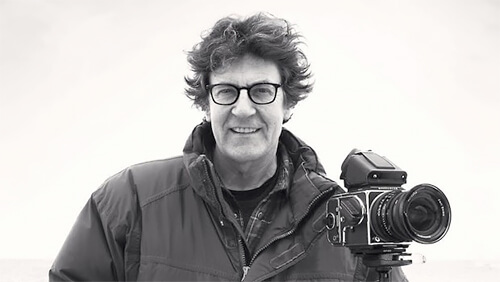Michael Kenna was born in Widnes, England in 1953. As one of 6 children born to a working class Irish-Catholic family, he initially aspired to enter the priesthood but his passion for the arts led him to The Banbury School of Art where he studied painting and then photography. Later he attended The London College of Printing and began working as a photographer and artist. He moved to San Francisco in 1977 where he was astounded by the number of galleries the city housed which allowed artists to showcase and sell their work. San Francisco has remained his home ever since.
Michael Kenna's work has often been described as enigmatic, graceful and hauntingly beautiful much like the Japanese landscape. Kenna first visited Japan in 1987 for a one-person exhibition and was utterly seduced by the country's terrain. Over the years he has traveled throughout almost the entire country constantly taking photographs. From these many treks the book Japan, featuring 95 of these photographs, was conceived.
The simplicity and clarity of Kenna's Japan alludes to rather than describes his subject allowing the viewer to have a completely unique and tailored interpretation. He has described this body of work as, "more like a haiku rather than a prose"; his work being like photographs written in short poem form. Kenna's photographs are often made at dawn or in the dark hours of night with exposures up to 10 hours. Kenna has said "you can't always see what's otherwise noticeable during the day... with long exposures you can photograph what the human eye is incapable of seeing".
Michael Kenna's prints have been shown in numerous exhibitions throughout the world with permanent collections in the Bibliotheque, Paris; The Museum of Decorative Arts, Prague; The National Gallery of Art, Washington DC; and the Victoria and Albert Museum, London. Kenna has also done a great deal of commercial work for such clients as Volvo, Rolls Royce, Audi, Sprint, Dom Perignon and The Spanish Tourist Board. Japan is one of 18 books of Kenna's photography to have been published to date.
Source: Supervision
With more than fifty monographs documenting his travels, Michael Kenna shows no signs of slowing down in his endless pursuit of nature's haunting beauty. Whether working in his native England, Easter Island, the coastal towns of France or the islands in Japan, Kenna seeks places of solitude which speak volumes about humanity.
Barren seascapes, abandoned fishing nets, fragmented piers, mysterious horizons, trees emerging from under snow drifts – these are just some of the images which dominate Michael Kenna's work from Japan. The result of his efforts can be seen in two books, Hokkaido (2006) and Japan (2002), both published by Nazraeli Press.
His newest book, Mont St Michel, continues his passion for solace. Originally built as a community for Benedictine monks, Mont St Michel became a place of prayer, meditation and silence. Kenna made may journeys to Mont St Michel, staying for days at a time, living among the residents, following their codes of silence and prayer. Armed with a camera, Kenna walked the halls, crypts and towers, watching shadows sneak their way around columns and spires, recording the passing of time.
Mont St Michel is dedicated to Michael's father who recently passed away. As Kenna states in his introduction: "My dad was a quiet man, he didn't seem to have a need to talk very much...We walked pretty much everywhere, and I liked to walk with my Dad...I think the time in-between destinations was most special for me. We didn't need to say very much to each other. Walking, observing, listening, waiting. Somehow I associate those walks with my time at Mont St Michel...He taught me that it's alright to walk alone sometimes."
Whether photographing in Mont St Michel, Japan, China, or the United States, Michael Kenna invites the viewer to walk along with him as he captures moments between events, when human presence seems right around the corner and silence is always present...
Source: Catherine Edelman Gallery

